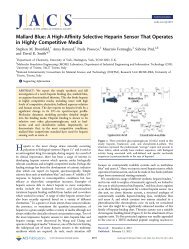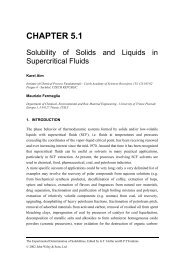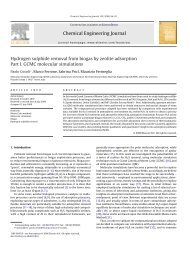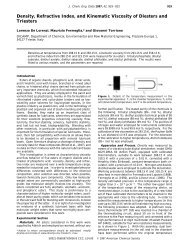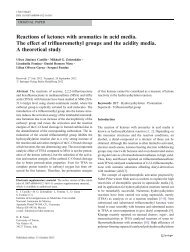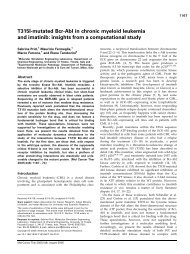Density, Viscosity, and Refractive Index for Binary ... - ResearchGate
Density, Viscosity, and Refractive Index for Binary ... - ResearchGate
Density, Viscosity, and Refractive Index for Binary ... - ResearchGate
You also want an ePaper? Increase the reach of your titles
YUMPU automatically turns print PDFs into web optimized ePapers that Google loves.
968 Journal of Chemical <strong>and</strong> Engineering Data, Vol. 44, No. 5, 1999Table 6. Experimental <strong>Refractive</strong> <strong>Index</strong> Data at 298.15 K<strong>and</strong> Calculated Molar Refractivity <strong>and</strong> <strong>Refractive</strong> <strong>Index</strong>by Lorentz-Lorenz Equation (Eq 7) <strong>and</strong> RefractivityDeviation Function (Eq 9) an DX φ exp calc eq 7 R ∆Rφ ∆Rxxn-C16 + (1-x) i-C80.0000 0.0000 1.3895 1.3895 39.33 0.0000 0.00000.0883 0.1464 1.3970 1.3964 42.66 -2.0932 0.05580.2009 0.3080 1.4045 1.4037 46.85 -3.8952 0.07060.2989 0.4301 1.4110 1.4092 50.61 -4.6685 0.19680.5217 0.6588 1.4202 1.4190 58.82 -4.9325 0.14540.5905 0.7186 1.4224 1.4214 61.35 -4.6256 0.12430.7245 0.8232 1.4264 1.4257 66.28 -3.5675 0.08550.8146 0.8861 1.4288 1.4283 69.61 -2.5765 0.07460.8690 0.9215 1.4305 1.4297 71.67 -1.8333 0.11751.0000 1.0000 1.4329 1.4329 76.41 0.0000 0.0000xn-C16 + (1-x) i-C160.0000 0.0000 1.4381 1.4381 76.11 0.0000 0.00000.1074 0.1088 1.4375 1.4374 76.15 0.0081 0.00780.2008 0.2031 1.4370 1.4369 76.18 0.0146 0.00980.3079 0.3110 1.4364 1.4363 76.21 0.0147 0.00760.4074 0.4109 1.4359 1.4358 76.25 0.0208 0.01780.4557 0.4593 1.4356 1.4355 76.26 0.0143 0.01330.4839 0.4875 1.4355 1.4354 76.28 0.0217 0.02480.6038 0.6072 1.4349 1.4347 76.31 0.0246 0.01890.6112 0.6146 1.4348 1.4347 76.31 0.0151 0.01660.7336 0.7364 1.4342 1.4341 76.34 0.0160 0.00990.7952 0.7975 1.4340 1.4338 76.38 0.0304 0.03141.0000 1.0000 1.4329 1.4329 76.41 0.0000 0.0000xn-C16 + (1-x) i-C190.0000 0.0000 1.4370 1.4370 90.30 0.0000 0.00000.0924 0.0799 1.4367 1.4366 89.03 -0.1599 0.01340.1750 0.1532 1.4363 1.4363 87.87 -0.3006 0.00080.2639 0.2342 1.4360 1.4359 86.64 -0.4001 0.00560.4541 0.4151 1.4352 1.4351 84.00 -0.5311 0.00740.5628 0.5234 1.4348 1.4347 82.50 -0.5254 0.01730.7037 0.6696 1.4342 1.4341 80.55 -0.4513 0.02440.7808 0.7524 1.4340 1.4337 79.50 -0.3513 0.04530.8398 0.8173 1.4337 1.4335 78.67 -0.2795 0.03481.0000 1.0000 1.4329 1.4329 76.41 0.0000 0.0000xn-C16 + (1-x) i-C300.0000 0.0000 1.4503 1.4503 141.21 0.0000 0.00000.1077 0.0633 1.4493 1.4492 134.27 -2.8449 0.03900.1892 0.1156 1.4484 1.4482 128.99 -4.7347 0.04020.2797 0.1786 1.4473 1.4471 123.13 -6.5122 0.04460.4057 0.2765 1.4456 1.4454 114.97 -8.3259 0.04940.4961 0.3554 1.444 1.4440 109.06 -9.1225 -0.00270.5618 0.4179 1.4431 1.4429 104.85 -9.2877 0.04460.6065 0.4632 1.4422 1.4421 101.93 -9.2672 0.02120.6963 0.5621 1.4405 1.4404 96.11 -8.6739 0.02020.8181 0.7158 1.4377 1.4377 88.19 -6.6365 -0.00710.8941 0.8254 1.4358 1.4359 83.26 -4.4608 -0.01231.0000 1.0000 1.4329 1.4329 76.41 0.0000 0.0000a X, mole fraction; φ, volume fraction.A ){[( n 2 1 - 1n 2 1 + 2) 1 F 1] [( - n 12 - 1n 1 2 + 2) w 2F 1] [( + n 2 2 - 1n 2 2 + 2) w 2F 2] }Fwhere n 1 <strong>and</strong> n 2 are the pure component refractive indices,w j the weight fraction, F the mixture density, <strong>and</strong> F 1 <strong>and</strong>F 2 the pure component densities. The molar refractivitydeviation function shown in Figure 3 <strong>and</strong> reported in Table7 has been calculated by the following expression:where φ 1 <strong>and</strong> φ 2 are volume fractions <strong>and</strong> R, R 1 , <strong>and</strong> R 2the molar refractivity of the mixture <strong>and</strong> of the purecomponents, respectively. There is no general rule thatstates how to calculate a refractivity deviation function:(8)∆R ) R - φ 1 R 1 - φ 2 R 2 (9)Figure 3. Molar refractivity deviation function <strong>for</strong> n-hexadecane+ isooctane (O), + cyprane (]), + pristane (4), + squalane (0)system at 298.15 K.Table 7. Values of Coefficients <strong>and</strong> Relevant St<strong>and</strong>ardDeviations <strong>for</strong> Eq 9 in Terms of Volume Fractionsn-C16 +i-C8n-C16 +i-C16n-C16 +i-C19n-C16 +i-C30a 0 -19.9896 0.0711 -2.1497 -36.4684a 1 -5.7662 0.0499 0.3458 10.3481a 2 -1.8724 0.2342 -3.0455a 3 0.3332σ (cm 3 ‚mol -1 ) 0.0422 0.0072 0.0065 0.0179Table 8. Values of Coefficients <strong>and</strong> Relevant St<strong>and</strong>ardDeviations <strong>for</strong> Eq 9 in Terms of Mole Fractionsn-C16 -i-C8n-C16- i-C16n-C16 -i-C19n-C16 -i-C30a 0 0.6178 0.0754 0.0379 0.1256a 1 -0.7734 0.0498 0.1648 -0.2279a 2 0.0940 0.2805 0.0237a 3 1.8303σ (cm 3 ‚mol -1 ) 0.0339 0.0072 0.0063 0.0169Konti et al. (1997) report deviations in molar refractivitywith volume fraction referring to the Lorentz-Lorenzmixing rules. However, the molar refractivity is isomorphicto a volume <strong>for</strong> which the ideal behavior may be expressedin terms of mole fraction: in this case smaller deviationsoccur but data are more scattered because of the highersensitivity of the expression to rounding errors in the molefraction. For the sake of completeness, Table 6 reports bothcalculations of refractivity deviation function.Molar refractivity deviation was fitted to a Redlich <strong>and</strong>Kister-type expression <strong>and</strong> the adjustable parameters <strong>and</strong>the relevant st<strong>and</strong>ard deviation σ are reported in Tables 7<strong>and</strong> 8 <strong>for</strong> the expression in terms of volume fractions <strong>and</strong>in terms of mole fractions, respectively. The degree of thepolynomial was determined on the basis of the F test at95% confidence.Finally, it can be concluded that the expressions used<strong>for</strong> interpolating the experimental data measured in thiswork gave good results, as can be seen by inspecting the σvalues obtained.The experimental data measured in this work areinteresting inasmuch as they are able to give an insightinto the effects on density, flow, <strong>and</strong> refractivity that derivefrom mixing saturated alkane molecules of different <strong>for</strong>m<strong>and</strong> size in the the absence of polar or hydrogen bondcontributions.AcknowledgmentThe Authors are grateful to Dr. Alain Roux (UniversitèBlaise Pascal - Clermont Ferr<strong>and</strong>, France) <strong>for</strong> helpfulsuggestions.




